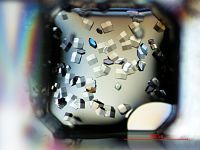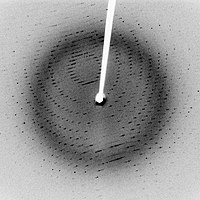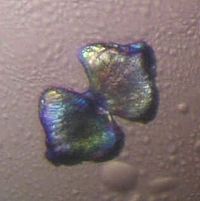Protein crystal
Protein crystals are examined in protein crystallography , they consist of purified protein and large amounts of crystal water . In a protein crystal, as in every crystal made of organic or inorganic compounds, identical molecules or molecular complexes are arranged in exactly the same way at the lattice points of the crystal lattice. The base of the crystal then consists of up to a few thousand atoms. The structure elucidation of proteins not only provides valuable information for basic research, but also increasingly supports the development of drugs in the pharmaceutical industry.
history
While the structure of crystals of simply built chemical compounds could be clarified relatively quickly with the still young method of X-ray structure analysis ( sodium chloride 1913, benzene 1928), great experimental difficulties arose with proteins, since they consist of thousands of atoms. The first difficulty was isolating, purifying, and crystallizing proteins. James Batcheller Sumner succeeded in doing this for the first time in 1926 with the enzyme urease and with the proteins concanavalin A and B from the jack bean . The use of protein crystallization as a general method was suggested by John Howard Northrop e.g. B. using pepsin 1929 show. Both researchers received the Nobel Prize in Chemistry in 1946 for these developments .
It was not until the early 1930s that the British physicist, crystallographer, and science historian John Desmond Bernal and his colleague Dorothy Crowfoot Hodgkin (who received the 1964 Nobel Prize in Chemistry alone) succeeded in obtaining sharp diffraction images from protein crystals. In order to determine the three-dimensional protein structure from these diffraction images , however, a great deal of computational effort was required, which only became easier to cope with with the development of the computer . The first structure of a protein ( myoglobin ) was elucidated by John Cowdery Kendrew with the help of X-ray crystallography in 1958 (Nobel Prize for Chemistry 1962, together with Max Perutz , who had decisively developed the method). With the advent of methods for genetic engineering production of recombinant proteins in the 1980s, the recovery was facilitated by proteins. Before that, the purification and characterization of a single protein represented the scope of a biochemical doctoral thesis. The genetic engineering methods made it possible to produce and purify many proteins in significantly increased quantities, which reduced the effort required for purification. Another milestone was the elucidation of the structure of the first membrane protein ( photosynthetic reaction center ) by Johann Deisenhofer , Robert Huber and Hartmut Michel , who were honored with the 1988 Nobel Prize for Chemistry. In the meantime tens of thousands of proteins and protein complexes - including large particles such as ribosomes (for the first time by Ada Yonath ) and viruses - have been crystallized and structurally characterized (see web link RCSB-PDB ).
properties
Protein crystals very rarely arise in the cytoplasm . A notable difference between small molecule crystals and macromolecular crystals is the very large amount of solvent in the latter. The crystal water of the protein crystals takes up about 30-80% of the crystal volume and is partly in a quasi-liquid form in the cavities between the protein molecules . Only a fraction of the protein surface is involved in crystal contacts, the rest is completely solvated, as a result of which protein crystals are very soft and fragile compared to ion or molecular crystals . In contrast to ion or molecular crystals, protein crystals are very sensitive to water loss. Due to the high water content, however, it is also possible to allow low molecular weight ligands, cofactors and substrates to diffuse from the surrounding mother liquor into the solvent channels in the crystal.
The large voids between the protein molecules can be illustrated by the fact that e.g. B. a colorless lysozyme crystal is colored continuously blue by adding methylene blue, but the dye is slowly released again by diffusion after transfer into a dye-free medium (analogous to zeolites ). This peculiarity of protein crystals is also used in the elucidation of the protein structure by crystal structure analysis by means of X-ray diffraction , in which heavy atom derivatives (e.g. uranium , mercury, etc.) are produced by placing the crystals in appropriate heavy metal salt solutions. Due to the chiral nature of naturally occurring proteins, they crystallize only in the 65 chiral of the 230 possible crystallographic space groups that have no mirror planes or inversion centers.
Manufacturing
In order to obtain sufficient protein, proteins are now often first overexpressed in E. coli or yeast , since the purification of the proteins is much easier and large amounts of protein can also be obtained very easily. Increasingly, proteins are expressed for crystallization in insect cell cultures and human HEK cells . The correct folding of some proteins is only made possible by the post-translational modifications of the higher eukaryotes , which can be essential especially for the production of membrane proteins .
The basic requirement for the production of protein crystals are sufficient quantities of highly pure protein. The protein molecules can be separated from other proteins by means of a combination of precipitation methods , chromatography or preparative electrophoresis . The crystallization conditions are then found by combining highly concentrated protein solutions (approx. 2–20 mg protein / ml) with various buffer solutions, which usually contain very high concentrations of salts (e.g. ammonium sulfate), alcohols (e.g. ethanol and Methylpentanediol) or polyethylene glycol (PEG), mixed in small drops with volumes in the nano to microlitre range and left to stand at constant temperature for days, weeks and months.
For germs to develop, the protein-precipitating agent mixture must be in the nucleation area, i. H. in the phase diagram in the oversaturated area. The following methods can be considered to gradually approach this area:
- Hanging or sitting-drop method : A drop of the protein solution with a low concentration of precipitant is on top or on the side of a vessel above a solution that has a high concentration of the precipitant. A diffusion of the solvent (water) gradually takes place over the gas phase , which leads to supersaturation in the drop.
- Diffusion across the phase boundary : protein solution and precipitant solution are brought into contact with one another in a capillary via a common phase boundary. The precipitant, with its much smaller particle size, diffuses through the interface into the protein solution.
In the batch process , the solution must already be in the nucleation area. The sample and the precipitant mixture are mixed together to form a drop under an insulating layer of oil.
Single crystals are required to clarify the crystal structure (corresponding crystals are shown in photos 1 and 2) - but much more often than these an amorphous precipitate or crystals are formed that are not suitable for such an investigation (photos 4 and 5). As soon as even small protein crystals grow, this is a great success, because the crystallization conditions can then be optimized. The decisive parameters for solubility are the pH value, “salting in”, “salting out”, ionic strength, organic solvents (dielectric constant) and temperature. The crystallization parameters should be tested at different temperatures, e.g. at 20 ° C and 4 ° C.
A new measuring method using high-intensity X-ray lasers, for example at the European XFEL , allows the use of the smallest single protein crystals, which are sprayed into the beam path in a water jet and produce individual diffraction images.
However, there are also some proteins that cannot be crystallized, including most membrane proteins so far . In addition to the usual protein precipitating agents , these usually also require detergents or surfactants , e.g. B. the β-D-octylglucoside, which have a water-soluble part of the molecule and a hydrophobic part. The latter binds the hydrophobic (fat-soluble) transmembrane region, which mostly consists of α-helices. A larger number of surfactant molecules can then use the hydrophilic components to keep the membrane protein in an aqueous solution without aggregation and disordered precipitation occurring. Thus, the protein purification methods already mentioned can be used before various crystallization conditions can be tested.
Occasionally, crystallization approaches also lead to the formation of very strange crystals, such as a butterfly crystal (photo 5).
analysis
With the aid of X-ray diffraction , both protein single crystals (see Laue method ) and crystalline protein powders (see Debye-Scherrer method ) can be examined.
Potential protein single crystals are usually frozen in liquid nitrogen before being examined in the single crystal diffractometer and then mounted in a gas flow at approx. −170 ° C in order to reduce the damage to the protein crystal caused by the interaction with the X-rays . Scattering crystals do not yet mean that they are protein crystals, since salts often crystallize out of the buffer solutions . These can be differentiated from protein crystals by examination using an X-ray diffractometer, because both produce very typical, different scatter images.
For the examination by means of X-ray diffraction (depending on the method used) single crystals of high quality and purity are required, the production of which is very complex. Therefore, high-throughput screening or automated methods are increasingly being used in research and industry to purify a large number of proteins and to test crystallization conditions. Some measuring stations ( beamlines ) on synchrotron systems that work with high-intensity X-rays are now equipped with robots that analyze the diffraction behavior of protein crystals, select suitable specimens for structural elucidation and, if necessary, measure complete diffraction data sets.
Recently, X-ray lasers like the European XFEL allow high pulse rates, i. H. An X-ray flash is generated every 220 nanoseconds, which ideally generates the diffraction image of a microcrystal located in the beam path. The method is based on the continuous measurement of many thousands of crystals, the diffraction of which ultimately provides a complete data set of structure factors. As soon as the corresponding phase information is obtained, electron densities can be calculated as with the more conventional methods of X-ray structure analysis and a three-dimensional model of the protein with atomic coordinates can be created.
literature
- Bernhard Rupp: Biomolecular Crystallography: Principles, Practice, and Application to Structural Biology Garland Science, Taylor & Francis Group, New York 2010, ISBN 978-0-8153-4081-2
Web links
- PDBe Protein DataBank in Europe - The database of freely accessible atomic coordinates of biomolecules in Europe
- PDBj Protein DataBank Japan - The database of freely accessible atomic coordinates of biomolecules in Japan
- RCSB-PDB Research Collaboratory for Structural Bioinformatics - The database of freely accessible atomic coordinates of biomolecules in America
Individual evidence
- ↑ a b c d e Wermuth, CG; Aldous, David; Raboisson, Pierre; Rognan, Didier: The practice of medicinal chemistry . 4th edition. London, UK, ISBN 978-0-12-417213-5 .
- ↑ JC Kendrew, G. Bodo, HM Dintzis, RG Parrish, H. Wyckoff, DC Phillips: A three-dimensional model of the myoglobin molecule obtained by x-ray analysis . In: Nature . 181, No. 4610, March 1958, pp. 662-666. doi : 10.1038 / 181662a0 . PMID 13517261 .
- ↑ Space Group Frequencies of PDB holdings.
- ^ Nicolas Brener, Faiz Ben Amar, Philippe Bidaud: Designing Modular Lattice Systems with Chiral Space Groups. (PDF; 4.0 MB) October 31, 2007.
- ^ A. Pandey, K. Shin, RE Patterson, XQ Liu, JK Rainey: Current strategies for protein production and purification enabling membrane protein structural biology. In: Biochemistry and cell biology = Biochimie et biologie cellulaire. Volume 94, number 6, December 2016, pp. 507-527, doi : 10.1139 / bcb-2015-0143 , PMID 27010607 , PMC 5752365 (free full text) (review).
- ↑ L. Schuldt, J. Müller-Dieckmann, MS Weiss: Crystallization of biological macromolecules, PdN Chemie in der Schule No. 2/60 year 2011, Aulis Verlag, p. 11.
- ↑ a b Desy News on the European XFEL at www.desy.de , accessed on July 19, 2020.
- ↑ Macromolecular Crystallography, Part 3, Charles W. Carter, Jr., Academic Press, 2003, ISBN 0-08-049709-8 , p. 264 ( limited preview in Google Book Search).




